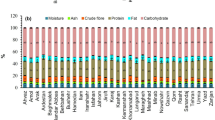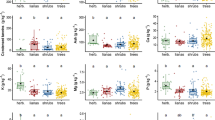Abstract
The microscopic analysis of leaflet, petiole, stem and peduncle of 26 populations of 17 Trifolium species was carried out in order to examine their structural characteristics related to digestibility, to compare them between the populations of forage species and their wild relatives and to evaluate, from histological aspect, the potential of wild-growing species to be used as forages. Forage species had low proportion of the tissues composed of thick-walled cells and high proportion of the tissues composed of thin-walled cells in all examined plant parts. The reduction of the proportion of lignified xylem, sclerenchyma and sclerenchymatous interfascicular parenchyma, were suggested as basic selection criteria in breeding Trifolium species for improved digestibility. T. angulatum, T. medium and T. pannonicum proved to be very similar to the forage species in their histological composition, proportion of thick-walled and thin-walled cells and type of variation of the examined parameters. We believe that these species have some potential for use as forages in their own right, but aditional biochemical, physiological and morphological investigations should be conducted.


Similar content being viewed by others
References
Akin DE, Robinson EL (1982) Structure of eaves and stems of arrowleaf and crimson clovers as related to in vitro digestibility. Crop Sci 22:24–29
Bruinenberg MH, Valk H, Korevaar H, Struik PC (2002) Factors affecting digestibility of temperate forages from seminatural grasslands: a review. Grass Forage Sci 57:292–301
Buxton DR, Redfearn DD (1996) Plant limitations to fiber digestion and utilization. In: Proceedings of the 37th annual ruminant nutrition conference “New developments in forage science contributing to enhanced fiber utilization by Ruminants”, Washington, DC
Cincovic T (1972) Genus Trifolium L. In: Josifovic M (ed) Flora SR Srbije IV. SANU, Beograd, pp 424–471
Coombe DE (1972) Trifolium L. In: Tutin TG et al. (ed) Flora Europaea, vol 2. University Press, Cambridge, pp 157–172
Guines F, Julier B, Ecalle C, Huyghe C (2003) Among and within-cultivar variability for histological traits of lucerne (Medicago sativa L.) stem. Euphytica 130:293–301
Jahufer MZZ, Cooper M, Ayres JF, Bray RA (2002) Identification of research to improve the efficiency of breeding strategies for white clover in Australia—a review. Aust J Agric Res 53:239–257
Jones A, Reed R, Weyers J (2003) Practical skills in biology. Pearson Education Limited, United Kingdom
Julier B, Huyghe C (1997) Effect of growth and genotype on alfalfa digestibility in a multilocal trial. Agronomie 17:481–489
Jung HJG, Lamb JFS (2003) Identification of lucerne stem cell wall traits related to in vitro neutral detergent fibre digestibility. Anim Feed Sci Technol 110:17–29
Lloveras J, Iglesias I (2001) Morphological development and forage quality changes in crimson clover (Trifolium incarnatum L.). Grass Forage Sci 56:395–404
Marshall AH, Abberton MT, Collins R, Bowen D (2003) Exploiting genetic resources in breeding clover for sustainable grassland systems. Czech J Genet Plant Breed 39:23–27
Morris JB, Green SL (2001) Defining a multiple-use germplasm collection for the genus Trifolium. Crop Sci 41:893–901
Pecetti L, Piano E (1998) Leaf size variation in subterranean clover (Trifolium subterraneum L. sensu lato). Genet Resour Crop Evol 45:161–165
Rezvani Moghaddam P, Wilman D (1998) Cell wall thickness and cell dimensions in plant parts of eight forage species. J Agric Sci 131:59–67
Rinne M, Olt A, Nousiainen J, Seppala A, Tuori M, Paul C, Fraser MD, Huhtanen P (2006) Prediction of legume silage digestibility from various laboratory methods. Grass Forage Sci 61:354–362
Sackville Hamilton R, Huges S, Maxted N (2001) Ex situ conservation of forage legumes. In: Maxted N, Bennett SJ (eds) Plant genetics resources of legumes in the Mediterranean. Kluwer Academic Publishers, Dodrecht
StatSoft, Inc. (2004) STATISTICA (data analysis software system), version 7. www.statsoft.com
Taylor NL, Gillett JM (1988) Crossing and morphological relationships among Trifolium species closely related to Strawberry and Persian clover. Crop Sci 28:636–639
Taylor NL, Gillett JM, Campbell JJN, Berger S (1994) Crossing and morphological relationships among native clovers of Eastern North America. Crop Sci 34:1097–1100
Taylor NL, Quesenberry KH (1996) Red clover science. Kluwer Academic Publishers, Dordrecht, Boston, London
Wilman D, Ahmad N (1999) In vitro digestibility, neutral detergent fiber, lignin and cell wall thickness in plant parts of three forage species. J Agric Sci 133:103–108
Wilman D, Rezvani Moghaddam P (1998a) Volume, surface area and cellular composition of chewed particles of plant parts of eight forage species and estimated degradation of cell wall. J Agric Sci 131:69–77
Wilman D, Rezvani Moghaddam P (1998b) In vitro digestibility and neutral detergent fiber and lignin contents of plant parts of nine forage species. J Agric Sci 131:51–58
Acknowledgement
This work was financially supported by the Ministry of Science, Republic of Serbia, Grant No. 143037.
Author information
Authors and Affiliations
Corresponding author
Rights and permissions
About this article
Cite this article
Krstic, L.N., Merkulov, L.S., Lukovic, J.Z. et al. Histological components of Trifolium L. species related to digestive quality of forage. Euphytica 160, 277–286 (2008). https://doi.org/10.1007/s10681-007-9574-4
Received:
Accepted:
Published:
Issue Date:
DOI: https://doi.org/10.1007/s10681-007-9574-4




